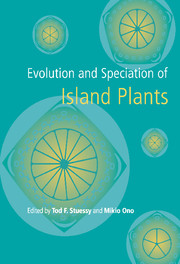Book contents
- Frontmatter
- Contents
- List of contributors
- Preface
- Acknowledgements
- Part one Hawaiian Islands
- Part two Juan Fernandez Islands
- Part three Southern and western Pacific Islands
- Part four General evolutionary patterns and processes on oceanic islands
- Introduction
- 11 Secondary compounds and evolutionary relationships of island plants
- 12 Chromosomal stasis during speciation in angiosperms of oceanic islands
- 13 The current status of our knowledge and suggested research protocols in island archipelagos
- Author index
- Taxon index
- Subject index
13 - The current status of our knowledge and suggested research protocols in island archipelagos
Published online by Cambridge University Press: 04 May 2010
- Frontmatter
- Contents
- List of contributors
- Preface
- Acknowledgements
- Part one Hawaiian Islands
- Part two Juan Fernandez Islands
- Part three Southern and western Pacific Islands
- Part four General evolutionary patterns and processes on oceanic islands
- Introduction
- 11 Secondary compounds and evolutionary relationships of island plants
- 12 Chromosomal stasis during speciation in angiosperms of oceanic islands
- 13 The current status of our knowledge and suggested research protocols in island archipelagos
- Author index
- Taxon index
- Subject index
Summary
Abstract
Evolution of higher plants on oceanic islands is now understood to be different in certain respects from that in plant groups of continental regions. This volume re-emphasizes the long-held view that island plants often undergo rapid speciation under directional selection through adaptive radiation. Such dramatic morphological change is usually not accompanied by changes in chromosome number (nor structural rearrangements) nor in genetic composition as evidenced by isozyme and RAPD loci. Geographic isolation, especially between islands, is fundamental as a stimulus for speciation. Change in island size and habitat spectra over geological time causes rapid ecological shifts and concomitant extinctions. Modern sources of data and methods of analysis have provided us with some of these newer perspectives and suggest continued research protocols involving: (1) basic floristic inventories using consistent species concepts; (2) preliminary evolutionary hypotheses; (3) geological data and history (especially of vulcanism); (4) explicit phylogenetic hypotheses; (5) estimates of character evolution, including co-evolution and adaptive complexes; (6) postulates of modes of speciation; (7) rigorous biogeographic analyses; and (8) communication of conservation priorities to appropriate officials and agencies.
This volume illustrates the breadth of plant island biological studies from the morphological to the molecular and from the phylogenetic to the biogeographic. The chapters contained herein reflect the dynamic nature of studies of oceanic islands, which in large measure parallel existing ideas and approaches now prevalent in modern plant systematics and evolutionary biology (e.g., Hoch & Stephenson, 1995).
- Type
- Chapter
- Information
- Evolution and Speciation of Island Plants , pp. 325 - 332Publisher: Cambridge University PressPrint publication year: 1998
- 2
- Cited by



